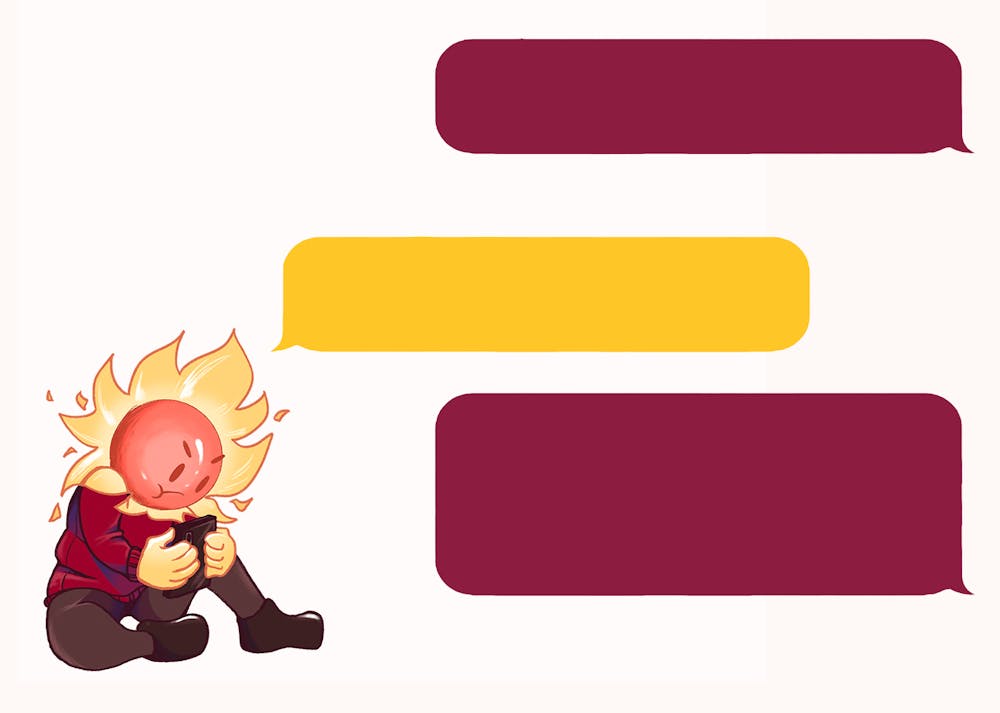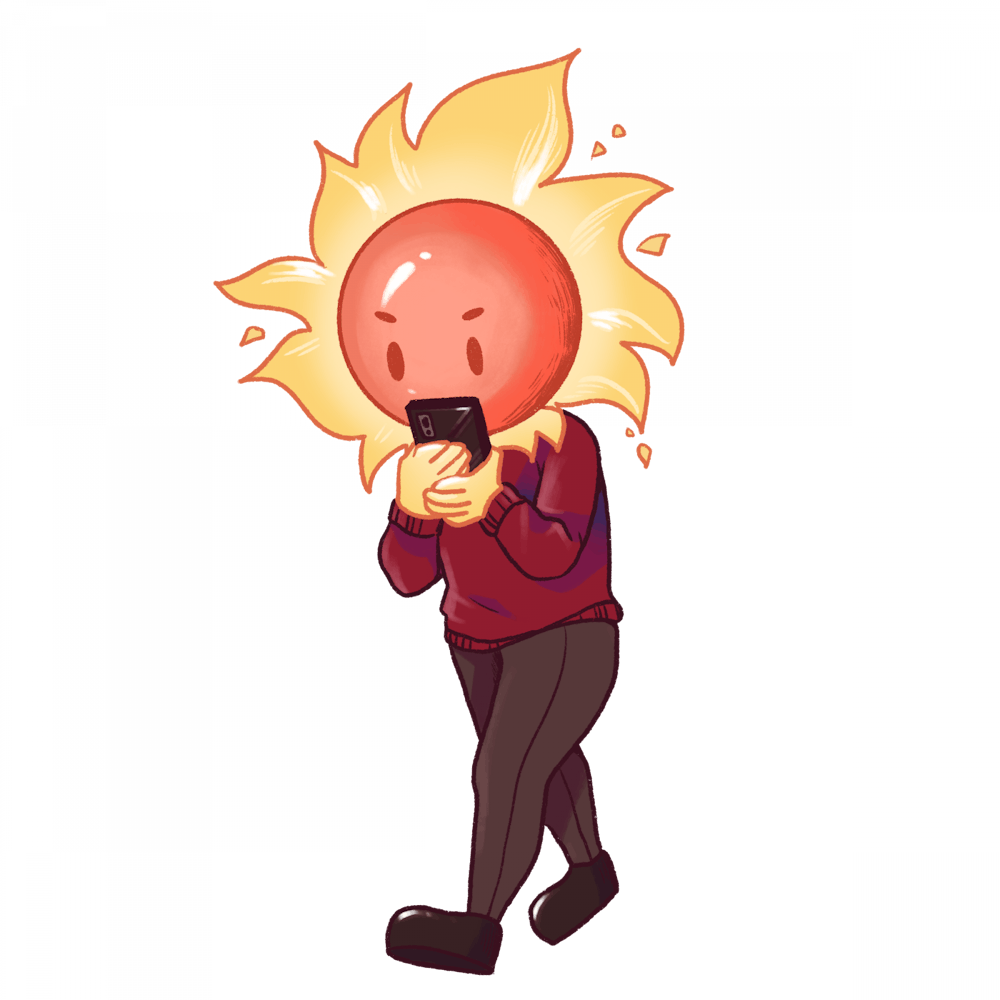College can be an intimidating place, especially for incoming freshmen. We could all use a friend to guide us in the right direction, a friend who is always a text away, ready to offer words of encouragement, plenty of emojis and a set of listening ears. Although this ‘friend’ may seem hard to come by, it’s already waiting to meet you.
Its name is ‘Sunny,’ and it has already connected with thousands of your ASU peers. Sunny is a chatbot responsible for sending automated messages throughout the year, updating you on fun events around campus, upcoming deadlines or sharing links to helpful resources ASU offers to those looking for academic or personal support.
In the past few years, Sunny has been a unique asset in the ASU admissions process, encouraging incoming Sun Devils to complete tedious orientation tasks in an easy, efficient way. But Sunny’s advancements go far beyond acclimating first-year students.
Sunny’s automated notifications became especially vital in the wake of COVID-19. Sunny was responsible for keeping students up-to-date with required daily health check reminders, the importance of wearing a mask on campus and ensuring students practice wellness like wearing masks and using hand sanitizer.
According to a report from Fierce Education, about 5,900 students engaged with Sunny to inquire about their classes and remote alternatives to ASU services in March 2020 — the height of the pandemic.
While Sunny seems to have established itself as a valuable tool for ASU students to use to their advantage, the usefulness of the chatbot has been questioned by some students over the years. Since Sunny was first introduced, many students have used ASU’s subreddit to share one-sided conversations instigated by students looking to provoke the chatbot.
Because Sunny is a chatbot, the line between artificial intelligence and human interaction is often blurred. Students sending everything between harsh swear words and professions of love to Sunny may be surprised when their response reaches the humans responsible for monitoring incoming texts.
Although subscribing to Sunny is completely optional, those who receive the automated messages — especially students who are no longer freshmen — have overall mixed attitudes toward the chatbot.
“They’re good reminders, but I don’t think it’s a super important or useful resource,” said Natalie Schultz, a senior studying business law. Schultz first subscribed to Sunny her freshman year and admits in her time at ASU, she has never been particularly interested in turning to Sunny for information.
“I personally don’t know anyone who has used Sunny,” she said. “Most of my friends are still subscribed to it because the texts are pretty infrequent, but they have the same opinions about it.”
In recent years, adopting new mechanisms of mass communication has become a common practice at many schools. Like ASU, Georgia State University has implemented its own chatbot, Pounce, to help recently accepted students with their enrollment process. Other schools, like Loyola University, rely on chatbot programming to aid advisors by finding students’ GPAs in seconds.
While chatbots seem to now be an essential tool in universities’ efforts to grow student success, Schultz said Sunny isn’t integral to ASU’s campus culture: “I don’t think it’s useless, but I don’t think automated text messages are going to foster a community,” she said. “You’re not communicating with other people at ASU, you’re communicating with an AI.”
The birth of Sunny
“We were very interested in being able to get information to students and, more importantly, have a resource that would help students quickly and on their own timeline,” said Matt Lopez, ASU’s deputy vice president of Academic Enterprise Enrollment. Since summer 2017, Sunny has been a tremendous asset to the admissions process, Lopez said.
“It originally started with us communicating with admitted students, then it expanded to prospective graduate and transfer students,” Lopez said. Sunny had already sent over 3 million messages to students by the beginning of 2020.
“The way of life right now is on a mobile phone,” Lopez said. “Being able to text important information to students in the palm of their hands has been very helpful on the recruitment side of things. We’ve been able to send messages like ‘We’re missing your transcript.’”
After Sunny’s debut in February 2018, an estimated 492 hours of staff time was saved that year thanks to the advanced programming of the chatbot, according to a 2019 presentation by Missy Pizzo, now associate vice president of Financial Aid and Scholarship Services. The ability to answer basic enrollment questions compensates for the excess emails and phone calls that ASU staff would normally deal with. But according to Lopez, Sunny’s help isn’t just for freshmen.
“First-year students are used to speaking with Sunny, so they lean on it, and the need changes as students get a little bit older. They’re not needing a reminder that this is the time of year you start planning for your next semester,” Lopez said. “The type of outreach changes over time, but I still think it’s just as effective.”
AI for the future
ASU uses Amazon Web Services — the platform the University used to create Sunny — extensively, according to Bobby Gray, executive director of products and projects at the University Technology Office. AWS offers the necessary components ASU needs to program Sunny to hold conversations with students, using a feature called ‘Lex.’
“Lex matches the text you type in with the utterances or questions we have,” Gray explained. The chatbot content system is designed to be responsive to a range of questions and answers the user inputs, accounting for slight variations in syntax, he said.
Director of the Provost Office Crystal Gustavson Miller elaborated on how Sunny’s messages make human contact: “When Sunny receives a message, the system is going to try and match it with the best possible response. And if it was unable to find a match at all, it will automatically flag the conversation as needing to be reviewed by staff members in the enterprise chatbot system.”
According to Miller, messages are flagged every day. “Students tend to ask very specific questions about their particular situation,” she said. “Sometimes we might have a response that it could match to, but they add something so specific it might throw the ball off a bit.”
While this may contradict Sunny’s ability to save time for staff members in charge of monitoring student responses, Gray said the more questions Sunny receives, the better it will respond.
“Over the years, we’ve grown the production architecture,” he said. “We can put out a ton of text now, but we’ve also been responsive to questions asked of us by students to build that knowledge base and support them.”
Peter Nagy, a lecturer in ASU’s Success by Design program, said chatbots generally have a positive impact on student experience. Nagy first joined the University as a postdoctoral researcher at the Center for Science and the Imagination, where he focused on implementing informal sciences — lifelong learning projects and experiences that are grounded in science, such as visiting a zoo or botanical garden — into school activities.
While Nagy is only relatively familiar with Sunny’s programming, he echoed Gray by noting how chatbots grow the more humans interact with them.
“That’s the beauty of chatbots,” Nagy said. “It uses large language models, and the more questions you ask it, the more it will adjust to the student population.”
Although Nagy views chatbots as an integral part of modern technology, he feels it’s important to recognize the imperfections these helpful tools still carry.
“These chatbots are not some magical entity,” Nagy said. “They’re not going to replace human support, but they can extend it and make it more effective.”
Edited by Camila Pedrosa, Alexis Moulton, Sam Ellefson and Greta Forslund.
This story is part of The Automation Issue which was released on March 15, 2023. See the entire publication here.
Reach the reporter at lmesqui2@asu.edu and follow @leahmesquitaa on Twitter.
Like State Press Magazine on Facebook, follow @statepressmag on Twitter and Instagram and read our releases on Issuu.





